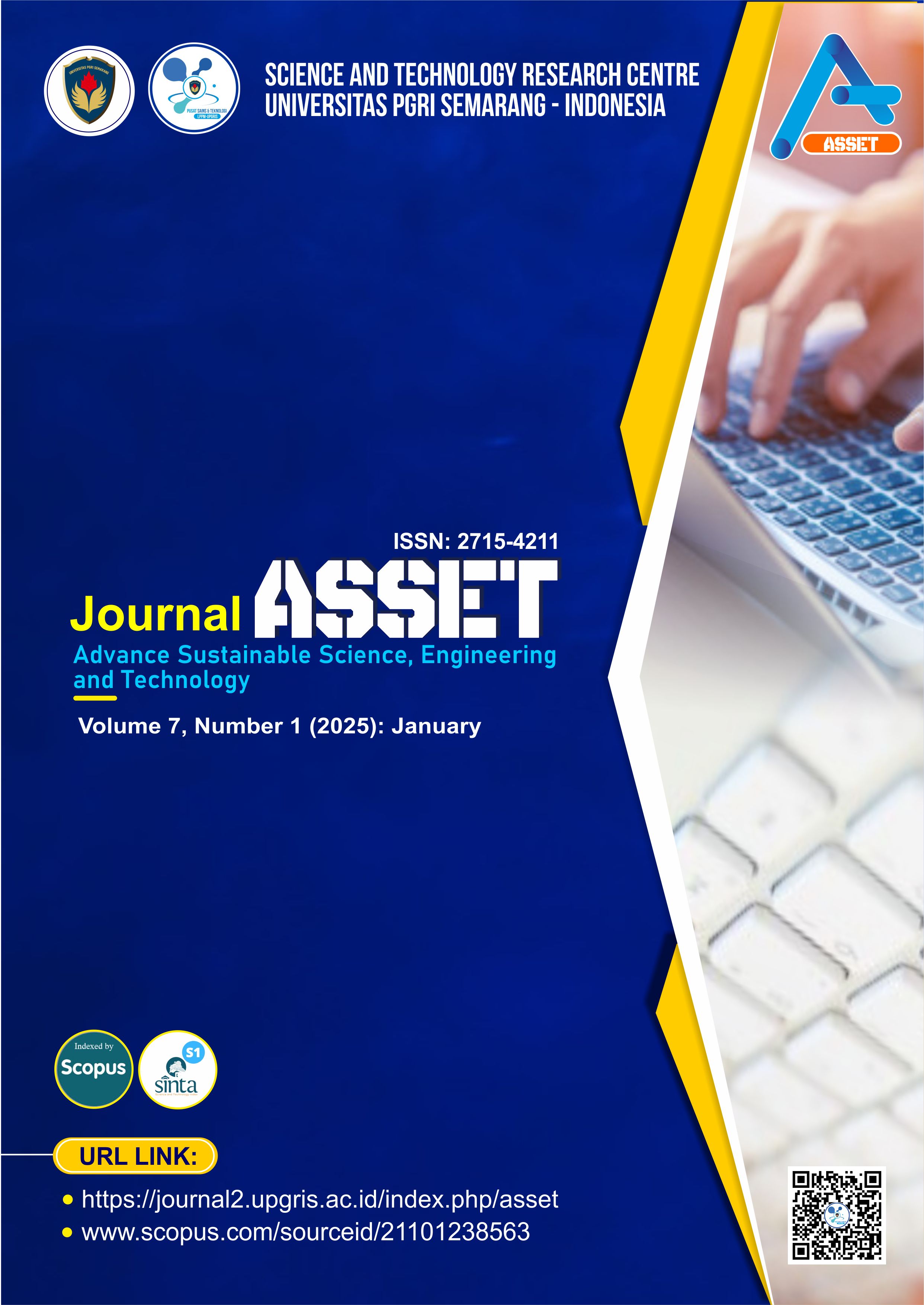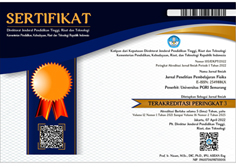Development of a Robotic System for Agricultural Pest Detection: A Case Study on Chili Plants
DOI:
https://doi.org/10.26877/asset.v7i1.1152Keywords:
ResNet, pest detection, chili plants, computer vision, Raspberry Pi, machine learning, AI in AgricultureAbstract
Chili peppers, a key agricultural commodity in Indonesia, are highly susceptible to pest infestations and diseases, leading to significant economic losses and challenges in sustainable farming. This study presents the design and implementation of a real-time pest detection system that integrates robotics, computer vision, and deep learning to enhance agricultural productivity. The system is built on a Raspberry Pi 5 and Arduino Mega Pro Mini, utilizing a camera for image capture and ultrasonic sensors for navigation. A ResNet-based model was trained on a dataset of 2,703 chili leaf images, categorized into healthy and diseased classes, achieving a detection accuracy of 91%. The system provides early warnings to farmers through a web-based interface, allowing timely intervention and reducing reliance on chemical pesticides. While promising, the system faced challenges such as environmental variability, which influenced image recognition accuracy. By automating pest detection and promoting precision farming, this innovation addresses the need for sustainable agricultural practices, contributing to global food security and reducing environmental impact.
References
[1] Anwar, M. T., Nugrohadi, S., Tantriyati, V., & Windarni, V. A. (2020). Rain Prediction Using Rule-Based Machine Learning Approach. Vol 2, No 1 (2020): November-April.
[2] Cahyani, A. N., Zeniarja, J., Winarno, S., Putri, R. T. E., & Maulani, A. A. (2024). Heart Disease Classification Using Deep Neural Network with SMOTE Technique for Balancing Data. Vol 6, No 1 (2024): November-January..
[3] Crisostomo, J. L. B., & Dizon, J. R. C. (2021). 3D Printing Applications in Agriculture, Food Processing, and Environmental Protection and Monitoring. Vol 3, No 2 (2021): May-October.
[4] El Hakim, E. B., & Aryanto, J. (2024). Automated Maintenance System For Freshwater Aquascape Based On The Internet Of Things (IoT). Vol 6, No 1 (2024): November-January.
[5] Firmansyah, M. R., & Astuti, Y. P. (2024). Stroke Classification Comparison with KNN through Standardization and Normalization Techniques. Vol 6, No 1 (2024): November-January.
[6] Hanggara, P., Alfianto, A. S., Purnama, L. P., & Tanra, I. (2024). Portable Low-Cost Home Sleep Monitor using Wemos D1 Mini. Vol 6, No 2 (2024): February-April.
[7] Kamila, I. P., Sari, C. A., Rachmawanto, E. H., & Cahyo, N. R. D. (2024). A Good Evaluation Based on Confusion Matrix for Lung Diseases Classification using Convolutional Neural Networks. Vol 6, No 1 (2024): November-January
[8] Nabila, E. A., Sari, C. A., Rachmawanto, E. H., & Doheir, M. (2023). A Good Performance of Convolutional Neural Network Based on AlexNet in Domestic Indonesian Car Types Classification. Vol 5, No 3 (2023): August-October
[9] Pradisthi, A. S., & Aryanto, J. (2023). Monitoring and Automation System for Bird Feeding and Drinking Based on Internet of Things Using ESP32. Vol 5, No 3 (2023): August-October..
[10] Pramudita, P., & Aryanto, J. (2024). Overcoming The Buildup of Queues By Carrying Out the Concept of Self-Service Using Responsive Web-Based Applications. Vol 6, No 1 (2024): November-January.
[11] Permatasari, P. W., & Aryanto, J. (2024). Implementation Open Artificial Intelligence ChatGPT Integrated With WhatsApp. Vol 6, No 1 (2024): November-January.
[12] Prastiti, F. F., Sari, C. A., Rachmawanto, E. H., & Cahyo, N. R. D. (2023). Mangrove Tree Species Classification Based on Leaf, Stem, and Seed Characteristics Using Convolutional Neural Networks with K-Folds Cross Validation Optimization. Vol 5, No 3 (2023): August-October.
[13] Salsabilla, A., Handayani, A. S., Fadhilah, A., Ziad, I., Husni, N. L., & Huda, M. H. (2023). Design of Android and iOS Applications for Mobile Health Monitoring Devices. Vol 5, No 2 (2023): May-July.
[14] Sugiarto, D., & Farikhah, F. (2024). Sustainability Strategies of Traditional Vannamei Shrimp Cultivation in East Java: A Case Study in Kudu Hamlet, Lamongan District. Vol 6, No 2 (2024): February-April.
[15] Suryadi, G. R., Maslebu, G., & Trihandaru, S. (2021). Artificial Neural Network for Classifying Injected Materials under Ultrasonography. Vol 3, No 1 (2021): November-April.
[16] Utari, G. R., Maslebu, G., & Trihandaru, S. (2021). Automatic Complaints Categorization Using Random Forest and Gradient Boosting. Vol 3, No 1 (2021): November-April.
[17] Utami, E. B., & Aryanto, J. (2024). Automated Maintenance System for Freshwater Aquascape Based on IoT. Vol 6, No 1 (2024): November-January
[18] Wahyu, R. A., & Sari, C. A. (2023). Utilization of Heat from Geothermal Well Pipes as Electricity for Road Lighting Based on IoT. Vol 5, No 1 (2023): November-April.
[19] Wijayanto, A. W., & Rachmawanto, E. H. (2023). Sustainability Strategies of Traditional Vannamei Shrimp Cultivation in East Java: A Case Study. Vol 6, No 2 (2024): February-April
[20] Windarni, V. A., Nugrohadi, S., Tantriyati, V., & Anwar, M. T. (2020). Rule-Based Machine Learning Approach for Rain Prediction. Vol 2, No 1 (2020): November-April.
[21] Wijayanto, A. W., et al. (2020). Klasifikasi Penyakit Tanaman Cabai menggunakan Algoritma K-Nearest Neighbor (K-NN).
[22] Y. L. and Y. Z. (2020). Residual Network for Image Classification of Plant Diseases. Journal of Intelligent Information Systems.
[23] Y. Z. and Y. L. (2020). Image-Based Plant Disease Detection using Deep Learning. Sensors.
[24] Zhao, Z., Zheng, P., Xu, S., & Wu, X. (2019). Object Detection with Deep Learning: A Review. IEEE Transactions on Neural Networks and Learning Systems, 30(11), 3212-3232
[25] Zhu, X., & Goldberg, A. B. (2009). Introduction to Semi-Supervised Learning. Synthesis Lectures on Artificial Intelligence and Machine Learning, 3(1), 1-130.
[26] Zhang, W., et al. (2020). Plant Disease Recognition Based on ResNet Deep Learning Model. IEEE Access, 8, 96413-9646











